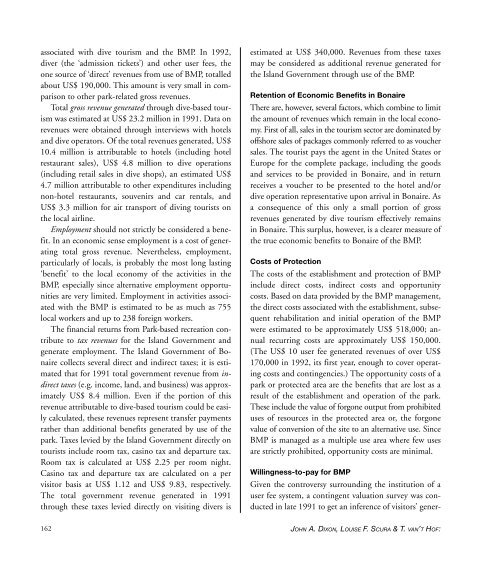Create successful ePaper yourself
Turn your PDF publications into a flip-book with our unique Google optimized e-Paper software.
associated with dive tourism and the BMP. In 1992,<br />
diver (the ‘admission tickets’) and other user fees, the<br />
one source <strong>of</strong> ‘direct’ revenues from use <strong>of</strong> BMP, totalled<br />
about US$ 190,000. This amount is very small in comparison<br />
to other park-related gross revenues.<br />
Total gross revenue generated through dive-based tourism<br />
was estimated at US$ 23.2 million in 1991. Data on<br />
revenues were obtained through interviews with hotels<br />
and dive operators. Of the total revenues generated, US$<br />
10.4 million is attributable to hotels (including hotel<br />
restaurant sales), US$ 4.8 million to dive operations<br />
(including retail sales in dive shops), an estimated US$<br />
4.7 million attributable to other expenditures including<br />
non-hotel restaurants, souvenirs and car rentals, and<br />
US$ 3.3 million for air transport <strong>of</strong> diving tourists on<br />
the local airline.<br />
Employment should not strictly be considered a benefit.<br />
In an economic sense employment is a cost <strong>of</strong> generating<br />
total gross revenue. Nevertheless, employment,<br />
particularly <strong>of</strong> locals, is probably the most long lasting<br />
‘benefit’ to the local economy <strong>of</strong> the activities in the<br />
BMP, especially since alternative employment opportunities<br />
are very limited. Employment in activities associated<br />
with the BMP is estimated to be as much as 755<br />
local workers and up to 238 foreign workers.<br />
The financial returns from Park-based recreation contribute<br />
to tax revenues for the Island Government and<br />
generate employment. The Island Government <strong>of</strong> Bonaire<br />
collects several direct and indirect taxes; it is estimated<br />
that for 1991 total government revenue from indirect<br />
taxes (e.g. income, land, and business) was approximately<br />
US$ 8.4 million. Even if the portion <strong>of</strong> this<br />
revenue attributable to dive-based tourism could be easily<br />
calculated, these revenues represent transfer payments<br />
rather than additional benefits generated by use <strong>of</strong> the<br />
park. Taxes levied by the Island Government directly on<br />
tourists include room tax, casino tax and departure tax.<br />
Room tax is calculated at US$ 2.25 per room night.<br />
Casino tax and departure tax are calculated on a per<br />
visitor basis at US$ 1.12 and US$ 9.83, respectively.<br />
The total government revenue generated in 1991<br />
through these taxes levied directly on visiting divers is<br />
estimated at US$ 340,000. Revenues from these taxes<br />
may be considered as additional revenue generated for<br />
the Island Government through use <strong>of</strong> the BMP.<br />
Retention <strong>of</strong> Economic Benefits in Bonaire<br />
There are, however, several factors, which combine to limit<br />
the amount <strong>of</strong> revenues which remain in the local economy.<br />
First <strong>of</strong> all, sales in the tourism sector are dominated by<br />
<strong>of</strong>fshore sales <strong>of</strong> packages commonly referred to as voucher<br />
sales. The tourist pays the agent in the United States or<br />
Europe for the complete package, including the goods<br />
and services to be provided in Bonaire, and in return<br />
receives a voucher to be presented to the hotel and/or<br />
dive operation representative upon arrival in Bonaire. As<br />
a consequence <strong>of</strong> this only a small portion <strong>of</strong> gross<br />
revenues generated by dive tourism effectively remains<br />
in Bonaire. This surplus, however, is a clearer measure <strong>of</strong><br />
the true economic benefits to Bonaire <strong>of</strong> the BMP.<br />
Costs <strong>of</strong> Protection<br />
The costs <strong>of</strong> the establishment and protection <strong>of</strong> BMP<br />
include direct costs, indirect costs and opportunity<br />
costs. Based on data provided by the BMP management,<br />
the direct costs associated with the establishment, subsequent<br />
rehabilitation and initial operation <strong>of</strong> the BMP<br />
were estimated to be approximately US$ 518,000; annual<br />
recurring costs are approximately US$ 150,000.<br />
(The US$ 10 user fee generated revenues <strong>of</strong> over US$<br />
170,000 in 1992, its first year, enough to cover operating<br />
costs and contingencies.) The opportunity costs <strong>of</strong> a<br />
park or protected area are the benefits that are lost as a<br />
result <strong>of</strong> the establishment and operation <strong>of</strong> the park.<br />
These include the value <strong>of</strong> forgone output from prohibited<br />
uses <strong>of</strong> resources in the protected area or, the forgone<br />
value <strong>of</strong> conversion <strong>of</strong> the site to an alternative use. Since<br />
BMP is managed as a multiple use area where few uses<br />
are strictly prohibited, opportunity costs are minimal.<br />
Willingness-to-pay for BMP<br />
Given the controversy surrounding the institution <strong>of</strong> a<br />
user fee system, a contingent valuation survey was conducted<br />
in late 1991 to get an inference <strong>of</strong> visitors’ gener-<br />
162 JOHN A. DIXON, LOUISE F. SCURA & T. VAN’T HOF:


















